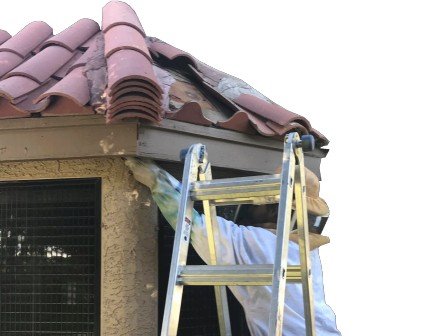Bee Hive Removal

Bee Removal and Relocation with Burns Pest Elimination
Bees are not exactly something you want to take on alone, especially if there’s a hive of them nesting on your Las Vegas, Tucson, or Phoenix property. When it becomes necessary to confront beehives head-on, professional bee and hive removal is crucial for not only your safety but also their “well-bee-ing.”
Learn more about the stinging insects to look out for and what to do if they become a problem near your home or business. Already know you need help getting rid of bees? Call or contact Burns Pest Elimination about bee control today!
Beware of Africanized Bees in Arizona and Nevada
Since the late 1990s, Africanized bees have become common in Phoenix and surrounding areas in Arizona. However, it is very difficult to tell the difference between an Africanized bee and a western (or European) honey bee. Burns is here to keep you safe and armed with the knowledge to help identify an Africanized bee colony.
Africanized bees:
- Are more aggressive than other bees and aggressively guard the hive.
- Sting in large numbers.
- Show great defensiveness when in a resting swarm.
- Swarm more frequently and travel farther than other types of bees.
- Are more likely to live in ground cavities than European bees.
- Will leave their hive and relocate the entire colony as a response to stress.
- Migrate as part of a seasonal response to decreased food supply.
- Deploy in greater numbers for defense and pursue threats over long distances from the hive.
Stung by a Bee?
If you have ever had the displeasure of being stung by one of these buzzing bugs, you know the pain and discomfort that comes along with it. Although reactions vary from person to person, a bee sting can pose a very serious health and safety threat to both humans and animals. Some people are able to withstand many stings at once, while people with bee allergies cannot handle even one. Especially if this is the first time you’ve been stung by a bee, take caution and closely monitor your reaction.
What to Do After a Bee Sting
- Stay calm, and get to a safe indoor location.
- If stingers are still in your skin, gently remove them with your fingernail, a credit card, or a blunt knife. (Do not squeeze! This increases the risk of more venom being injected.)
- Apply a cold compress to relieve pain and swelling. Do not apply ice directly to the sting site.
- If you or someone else is stung multiple times and experiencing an allergic reaction, call 9-1-1 immediately.
- If you know that you are allergic to bee stings, consult your doctor about a preventative anti-venom first-aid kit.
Bee Sting Symptoms
- At the site of the sting, localized itching, swelling, and minor stinging sensations are normal and should subside within a few hours.
- Symptoms of an allergic reaction to a bee sting include burning, excessive itching, body swelling, body rash, difficulty breathing, weakness, nausea, shock, or unconsciousness.
- If itching continues for a prolonged period, or if you appear to be having some sort of allergic reaction, see a doctor as soon as possible. If you have more than 10 stings or notice any symptoms other than localized pain, itching, or swelling, seek immediate medical attention.
Contact Burns for Professional Bee Control and Hive Removal
Due to their potential health hazards and the similarities between European and Africanized bees, Burns Pest Elimination approaches all bees as if we were dealing with the most aggressive. If stinging insects are nesting around your residential or commercial property, rest assured we’ll send someone out to handle bee and hive removal with the utmost safety and care. Get in touch or request a free quote from Burns to take back your home and yard!